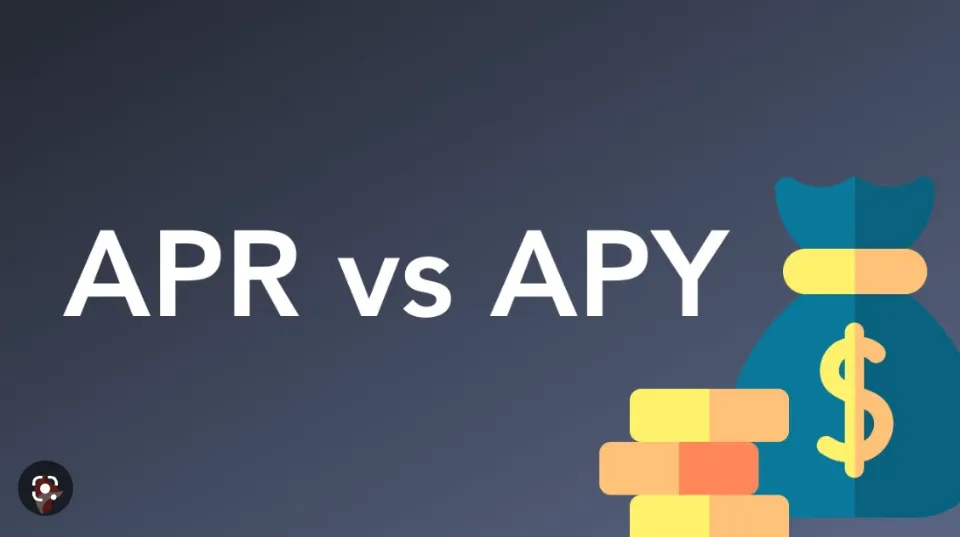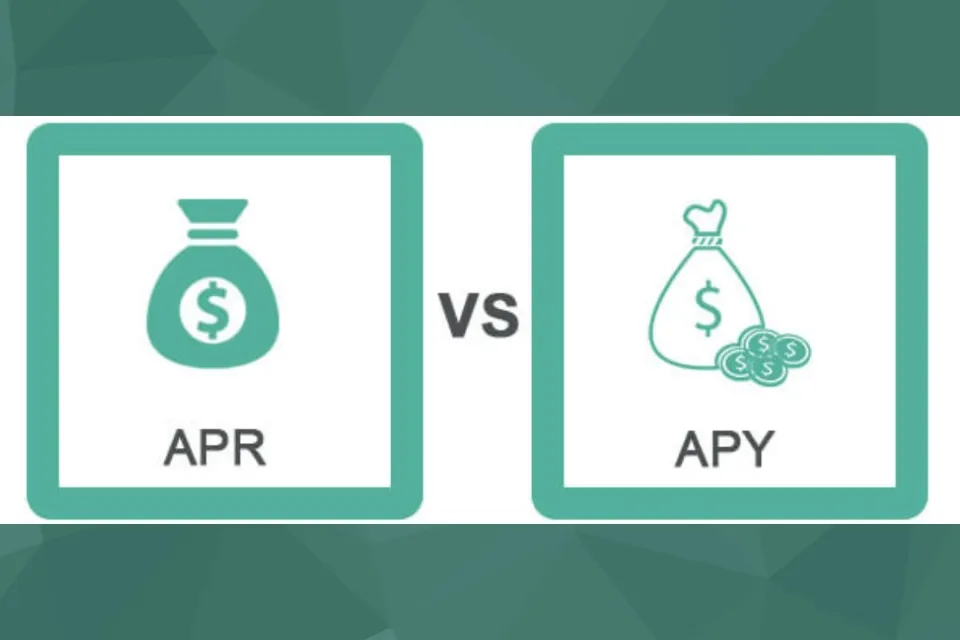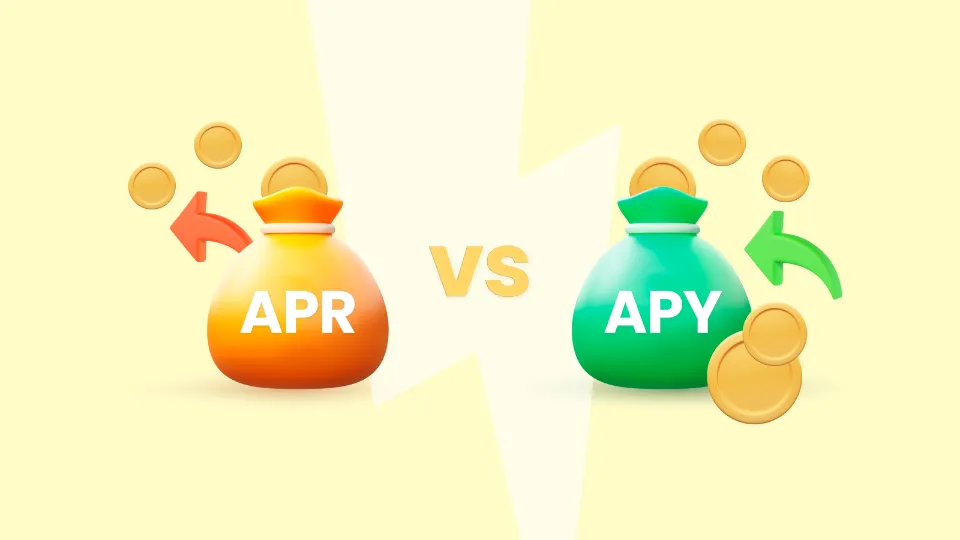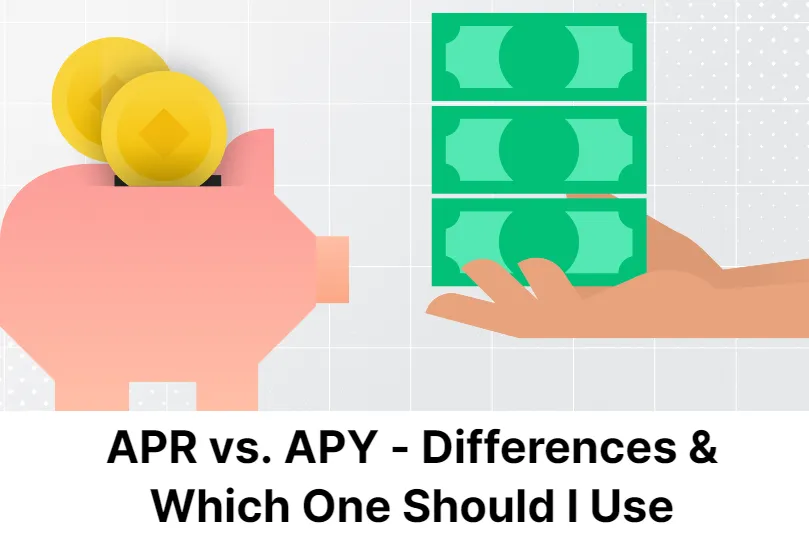People who dabble in finance, particularly personal finance, may be familiar with the two key terms, APR and APY. For those who are learning about personal finance for the first time, these terms can be quite confusing. These concepts are used to figure out the interest on accumulated investments and other credit products. When applied to account balances, they can significantly affect your earnings or payments.
The interest paid on borrowings, such as loans from DeFi applications, is displayed using the APR. An investment’s annual percentage yield, or APY, is its return.
You should be aware that APR and APY aren’t exactly the same and aren’t even equal. Let us know about the two terms in-depth and understand the key differences.
What is Compound Interest?

Let’s first examine compound interest. In simpler terms, compound interest means the interest being paid upon the prior interest. Suppose your bank decides to give you interest as per compound interest. If so, they will evaluate a fresh sum each month to calculate the interest, which may cause the compound interest formula to change.
Also Read: Crypto Compare Guide 2023 – Exchanges, Wallets, Tokens & More
APR – Annual Percentage Rate
APR is an abbreviation for annual percentage rate. Of the two terms, this is the less complicated. The annual percentage rate, or APR, can be thought of as the guaranteed interest that a lender will receive on their investment. Additionally, the borrower spreads out the payment of interest over a year.
Consider this instance.
You just opened a savings account at the bank, and you’ve already deposited $1,000 into it as a starting sum. 20% is a reasonable annual percentage rate (APR) for the money in the savings bank account. This means that after a year, you will have to pay $200 in interest. The interest you’ll pay after a year is calculated by multiplying the initial principal amount by the annual percentage rate (APR).
The initial principal in this instance is $1,000, and the annual percentage rate is 20%. You are obligated to pay a total of $1,200 by multiplying the two amounts. This sum will rise in line with that. Here, the initial principal amount will rise to $1,400 after the second year, and then to $1,600 after the third.
You’ll see how a fixed amount of $200 (calculated during the initial amount involved) adds up every year. Because there is only simple interest involved, this needs to be kept in mind.

What is APR in Crypto?
Lending their cryptocurrency also generates income for the cryptocurrency’s creators and subsequent lenders. Instead of compound interest, as is the case with traditional loans, the borrower is responsible for covering other one-time costs.
APR is straightforward and has no additional costs of any kind. The interest is calculated only on the initial loan amount and is fixed.
Now, let us look at the more difficult and much different term- APY.
APY – Annual Percentage Yield
Annual Percentage Yield is known as APY. In contrast to the annual percentage rate (APR) model, where your interest payment is a fixed sum determined by the initial principal amount, you will receive some interest each month under the annual percentage yield.
Earned Annual Interest, or APY, is another name for compound interest.
Recall the $1,000 that is currently in our savings bank account. If we use the calculated APY method, the bank will add the interest each month, leaving you with $1,249 at the end of the year. You got that instead of the APR method, which was $49 more.
This is how APY has power. It produces better results despite being more difficult. After three years, the $1,000 would have been converted into $1,813, a decent amount of $213 more than what we’ll receive from the AYP method.
What is APY in Crypto?
APY is the same in cryptocurrency and conventional money lending systems. The loan amount in this case is cryptocurrency. Since the annual percentage yield simply gives the lenders more money, developers and cryptocurrency expert advisors frequently opt for it. Investors can start earning an APY on their Bitcoin by using blockchain platforms, cryptocurrency exchanges, or cryptocurrency wallets. With the aid of yield farming, they stake their coins and provide liquidity to liquidity pools. To put it simply, APY is more useful and profitable than APR, at least when taking cryptocurrency experts into account.
You must thoroughly learn crypto trading if you want to comprehend this topic more and actually start making money from it.

Key Differences Between APR and APY
| APR | APY |
| APR is inclusive of all charges | APY calculates interest rates only |
| It does not carry the compounding principle | It follows the compounding principle |
| Amount in APR ranges variably | Amount in APY remains constant |
| It is usually associated with credit accounts | It is generally associated with deposit accounts |
Here are some of the critical differences between APR and APY –
- Annual Percentage Rate (APR) calculates the interest rate, including all fees, by factoring in fees and other costs associated with a loan or investment. In contrast, the interest rate is determined by the Annual Percentage Yield, which also takes into account the frequency of compounding.
- The frequency of compounding may also be taken into consideration by APR on occasion. Contrarily, the ability and impact of compounding is the only factor taken into account by APY.
- As quoted by leaders, ‘APR is the interest rate you’ll pay if and when held until the loan is paid off at the scheduled time. Typically, the annual percentage rate varies from year to year depending on the loan. For APY, the formulas and calculations are what determine it. In the first year of the loan, the last year of the loan, and every year in between, the APY is the same.
- APR is more practical and informative with credit accounts. With deposit accounts, APR is a little less useful and instructive, but it usually depends on your usage.
Let us look at an even more specific example.
Let’s say you applied for a credit card from a banking institution. That credit card charges an interest rate of 1% every month. Consequently, a 12% annual interest rate would be automatically calculated.
This is not true of APY, which takes compound interest into account. In this case, an annual percentage yield (APY) of 1% would equal 12.68%. If you keep the same balance on your credit card for a month, you will be charged interest at a rate of about 12%. However, if you keep it for a full year, you’ll have to pay interest totaling 12.68%, which is.68% more than what you’ll be paying in the annual percentage rate, or APR.
The Borrower’s Perspective
When taking money or any loan from the market, a borrower strives to get the lowest interest rate possible. Therefore, you should generally be aware of the various ways a loan might be misrepresented as having a lower interest rate when looking at APR and APY.
So, when looking for a loan in the market, you will pick someone who offers the lowest interest rate. Even though the quoted rates might seem low, you could find yourself paying much more for the loan than you had anticipated.
This is due to the fact that the bank would simply state the annual percentage rate of the loan without specifying whether it was compounded semi-annually, quarterly, or monthly.
Therefore, if your bank estimates a 5% interest rate, you will pay 5.11% annually. This is due to the fact that financial institutions like banks and other lenders do not take into account or disclose the impact of compounding on loans.
You should also compare loan quotes from various lenders and the costs associated with them while looking for a loan.
Lenders Perspective
As the borrower’s adversary, you are here. If you intend to inform the borrower of the simple interest rather than taking into account the compound interest, you will be significantly impacted when a borrower makes an informed decision.
People who need loans naturally want to get them at the lowest interest rate possible. Likewise, those who will be lending loans will also wish to Lend (or receive interest if you deposit money in a bank account that will give you interest) at the highest possible rate.
Just be careful to look at the frequency of compounding on your lent money in enough detail. Compare them to other banks’ APY rates as well that compound at a similar rate. Your potential savings interest rate may be significantly impacted by it.
How to Compare Different Interest Rates?

From the example above, you can see that more interest can be earned when interest is compounded. APR or APY are two different ways that different products may display their rates. It’s crucial to compare using the same term because of this discrepancy. Be mindful when you compare products, as you may be comparing apples to oranges.
Products with a higher APY will not necessarily yield more interest than those with a lower APR. If you are aware of the frequency of compounding, you can quickly convert APR and APY using online tools.
The same is true of DeFi and other crypto products. To compare like with like when looking at products that might advertise using crypto APY and APR, such as crypto savings and staking, make sure to convert them.
Additionally, confirm that the compounding periods are the same when comparing two DeFi products with APY. If two accounts have the same APR but one compounds daily and the other monthly, the daily compounding account might offer higher crypto interest.
Another important point to note is what APY means in relation to the specific crypto product you are reviewing. Some product collaterals use the term “APY” to refer to the rewards that one can earn in cryptocurrency over the selected timeframe, and not the actual or predicted returns/yield in any fiat currency. This is a crucial distinction to understand because the value of your investment (in fiat terms) may increase or decrease depending on the price of the underlying crypto asset. Even if you continue to earn an APY in crypto assets, if the value of your investment falls sharply, it might still be less than the initial amount you invested in fiat. As a result, it is crucial that you carefully read the applicable product terms and conditions and conduct your own research to fully comprehend the investment risks involved and what APY means in that particular situation.
APR Vs. APY in Crypto: Which is Better?
APR and APY are nearly identical in cryptocurrency trading. APY includes compound interest while APY only takes into account simple, ordinary interest. As a result, APY is thought to be the better option.
Conclusion
APR and APY are crucially essential concepts to understand for much more effective and efficient management of your finances. When interest is typically compounded more frequently, the difference between APR and APY widens significantly. Be aware of the various rates offered when looking for a loan, applying for a credit card, or trying to get the highest rate of return on a savings account.
The interest rates that financial institutions typically quote to different borrowers and lenders vary greatly. You need to make sure you understand the rates. These financial institutions are providing them with quotes; they then compare these quotes to those offered by other institutions. You’ll be surprised by the amount of the difference, and the loan with the lowest advertised rate may end up being the most expensive.
FAQs
Is APR Better Than APY?
APRs give you a general idea of what you might owe, whereas APYs give you the most accurate idea of an account’s earning potential. Since both are shown over a single year, they are more accurate than interest rate alone.
What Does APY Vs APR Mean Crypto?
APR and APY are very similar in terms of cryptocurrency trading. In contrast to APY, which takes into account both compound and simple, ordinary interest. The better option is therefore thought to be APY.
What is 5.00% APY Mean?
What does an APY of 5.00% mean? A 5% annual percentage yield means that your money will grow by 5%. At the end of a year, you would have $105 if you deposited $100 in an account that compounds annually. But accounts may compound monthly, weekly, daily or even continuously.



